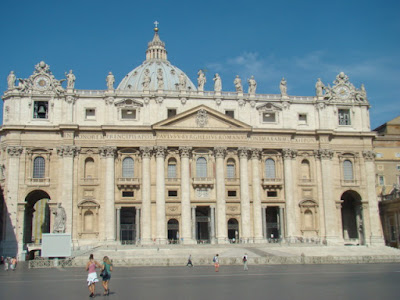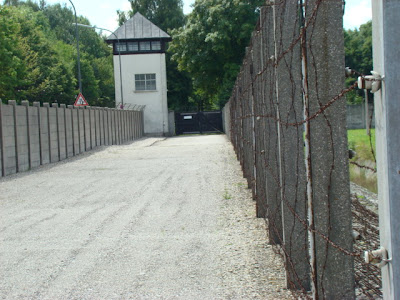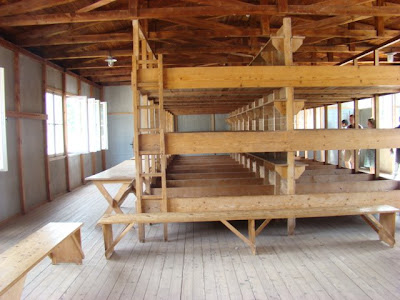Thanks to all of you - family and friends - for sharing this exciting journey with us. What a journey it has been with many laughs, enjoyable moments and memories for a lifetime.
Friday, July 31, 2009
Goodbye to Europe....
We've met so many wonderful people from every country and every walk of life. For the most part - everyone is like us - friendly (but they don't all have southern accents) and inquisitive.
We've ridden every type of train imaginable, been on boats and cable cars - almost run over by cars and bicycles and have been yelled at in Rome (at least, Sarah was).
How very thankful we are that we've been priviledged to have this experience - but most of all, we now know what a priviledge it is to live in the USA. In all our travels, we've yet to find a place that we'd rather be .....than home.
Again, thanks for coming along with us.....see you in America!!!
Posted by Sarah Walker Gorrell at 7:59 PM 0 comments
The Final Tour - Rome
Posted Friday, July 31, 2009.
 St. Peter's Basilica
St. Peter's BasilicaVatican City, comprised of 110 acres, sits in the middle of Rome - near the Tiber River. It is both the smallest and the wealthiest country, in the world.
No photos are allowed in the Sistine Chapel or in the Tombs. The Sistine Chapel ceiling is an elaborate mural of frescos by Michelangelo.
The tombs contain the remains of popes - including Pope John Paul II, one of the most beloved popes. His tomb,adorned with several flower arrangements, is guarded by two guards.
 Nero's fountain - also called his bathtub - in the Vatican Museum. Legend states that Nero would have the fountain filled with goat's milk so that he could bathe .....when children and the elderly did not have enough to eat.
Nero's fountain - also called his bathtub - in the Vatican Museum. Legend states that Nero would have the fountain filled with goat's milk so that he could bathe .....when children and the elderly did not have enough to eat.The mosaic tiled floor is over 2,000 years old.
The High Altar in St. Peter's Basilica.
 The Papal Canopy over the altar is of bronze by Bernini in 1633. It is located over the tomb of St. Peter.
The Papal Canopy over the altar is of bronze by Bernini in 1633. It is located over the tomb of St. Peter.One of many confessionals located in St. Peter's Basilica.
 Vatican City is guarded by the Swiss Guards - 100 in number. They must be Catholic males and must take a vow to give their life for the Pope, if necessary.
Vatican City is guarded by the Swiss Guards - 100 in number. They must be Catholic males and must take a vow to give their life for the Pope, if necessary.Posted by Sarah Walker Gorrell at 5:07 PM 0 comments
Thursday, July 30, 2009
When the souvenir bags are full....
We've come full circle - we're back where we started, in Rome. The extra bag that we bought for souvenirs is full, so it's time to head back home.
Today has been a "rest" day in Rome, after a 10 hour overnight train ride from Austria (and not much sleep). Tomorrow, we will tour the Vatican, Sistine Chapel and St. Peter's.
We are almost "looked out" ....our minds are unable to absorb much more, and our hearts are longing to be back home.
Posted by Sarah Walker Gorrell at 5:49 PM 1 comments
A castle, a cathedral and music...
Posted Thursday, July 30, 2009 from Rome - photos taken in Austria on Wednesday.

The Ambras Castle was built in the 15th century by Archduke Ferdinand II of Austria.
 The Cathedral of St. James - built in 1717 - was heavily damaged during WW II. It ranks as one of the prettiest churches that we saw, in Europe.
The Cathedral of St. James - built in 1717 - was heavily damaged during WW II. It ranks as one of the prettiest churches that we saw, in Europe. One of the paintings in the ceiling - which appears like a dome. The guide informed us that the painting is "as flat as a pancake" - but the technique used by the artist gives it a dimensional effect.
One of the paintings in the ceiling - which appears like a dome. The guide informed us that the painting is "as flat as a pancake" - but the technique used by the artist gives it a dimensional effect.At the end of our day, as we finished our dinner, we heard the sounds of a parade. We followed the music and were entertained by an Austrian band. During the month of July, each evening different bands from the regions of Austria, as well as neighboring countries, play in the courtyard of the Imperial Palace.
Posted by Sarah Walker Gorrell at 4:49 PM 0 comments
The Austrian Alps
Posted Thursday, July 30, 2009 from Rome - photos taken Wednesday, July 29, 2009 in Austria.
We awoke to a beautifully, clear day, without the clouds or fog, that had been forecast. The Austrian mountain air was crisp and cool. What a perfect time to ascend the mountain on the incline railway and cable cars. There aren't enough words - nor pictures - to describe the beauty of these mountains and the exhilaration that we felt just being there!
 The three of us with Innsbruck below us and one of the ranges of the Alps behind us, at the first stop (we went higher).
The three of us with Innsbruck below us and one of the ranges of the Alps behind us, at the first stop (we went higher).The skies above the mountains are full of hang-gliders and parasailers. We met a young man getting ready to "take off" from the mountainside. Ginny told him that her nephew, Chris Smith, was a hang-glider and, small world, he knew Chris from competition.
Wolfgang, on the side of the mountain, ready to soar.
Posted by Sarah Walker Gorrell at 11:39 AM 0 comments
Tuesday, July 28, 2009
The hills are alive, with the sound of music....
Posted Tuesday, July 28, 2009 - photos same day
 They sounded "like us" and played quite well, in spite of the fact that their instruments displayed several broken strings.
They sounded "like us" and played quite well, in spite of the fact that their instruments displayed several broken strings.Innsbruck sits in the valley surrounded on all sides by the Alps - such a beautiful setting. Today, the mountaintops have been covered by the low-hanging clouds. The winter olympics were held here in 1964 and again in 1976. The Junior Olympics will be here in 2012.
Our B&B (Hotel Weisses Kreuz) is in Old Town and was first mentioned in city chronicles in 1465. In 1769, Wolfgang Mozart slept here (in our room??). In 1945, Major Eliott, commander of the American Troops in WWII made this his temporary headquarters.
As Rick Steves might say, this is a "hidden gem" with good beds, larger bathroom than we've been accustomed to in other B&Bs - and again, real towels! It's also located in a great location in the heart of Old Town with sidewalk cafes everywhere.
 The Golden Roof (at the end of our street) is possibly Innsbrucks greatest tourist attraction. There are 2,600 gold-plated tiles covering the three story balcony. It was built by Archduke Frederich IV in the 15th century and was constructed for Emperor Maximilian I so that he could sit in luxury and enjoy tournaments in the square below, as well as watch his "subjects" as they went about their daily lives.
The Golden Roof (at the end of our street) is possibly Innsbrucks greatest tourist attraction. There are 2,600 gold-plated tiles covering the three story balcony. It was built by Archduke Frederich IV in the 15th century and was constructed for Emperor Maximilian I so that he could sit in luxury and enjoy tournaments in the square below, as well as watch his "subjects" as they went about their daily lives.Another of Innsbrucks ornate buildings - also at the end of our street in Old Town.
Tomorrow, we'll tour a castle, the Basilica and ride the Incline Railway up one of the mountains. And, tomorrow night (late) we will board our final European train as we make our way back to Rome for the last leg of this fabulous and memorable journey.
Sarah
Posted by Sarah Walker Gorrell at 6:04 PM 0 comments
Monday, July 27, 2009
Castles in the Bavarian Alps
Posted Monday, July 27, 2009 - photos same day
Our bus tour took us a couple of hours out of Munich to the castles of King Ludwig II - Linderhof and Neuschwanstein. The king was eccentric, and preferred to be alone, so both castles were in remote mountain settings.
Neuschwanstein, the largest of the two, was unfinished at the time of his death - but was the model for the castle at Disney World. Ludwig spent only six months in this mountain retreat.
It took a 30 minute hike up the mountain to reach the castle - or a ride in a horse drawn carriage. (No need to ask - I love horses!!) The walk back down was a piece of cake.
There were approximately 200 steps from the bottom floor of the castle to the top floor. The castle was not as ornate as Linderhof, but was an enormous structure. No photos allowed, and I didn't risk it this time.
Linderhof, where he lived for eight or nine years, was ornate and elaborate. The walls were covered in gold carvings.

 "Stolen" photo of settee in Music Room - I really wanted the photo of the ornate piano, but just couldn't risk two. (And, Bob was giving me really dirty looks about this time.)
"Stolen" photo of settee in Music Room - I really wanted the photo of the ornate piano, but just couldn't risk two. (And, Bob was giving me really dirty looks about this time.) Ginny in front of the Grotto at Linderhof.
Ginny in front of the Grotto at Linderhof. Bob and Sarah in front of Linderhof Castle - this one is for Robbie. She wasn't seeing any photos of her mom and dad, and was afraid I'd left him in the 'Red Light' district in Amsterdam!!
Bob and Sarah in front of Linderhof Castle - this one is for Robbie. She wasn't seeing any photos of her mom and dad, and was afraid I'd left him in the 'Red Light' district in Amsterdam!! The houses in the German villages have their own style - and most have paintings on the outside wall - like the one above.
The houses in the German villages have their own style - and most have paintings on the outside wall - like the one above. The German countryside is almost perfect - as if one were looking at a picture that had been drawn. The houses are all the same style with red roofs, flowers in windows boxes and fields that look manicured. This area of Germany has long, cold winters as demonstrated by the stacks and stacks of firewood already stacked in place.
The German countryside is almost perfect - as if one were looking at a picture that had been drawn. The houses are all the same style with red roofs, flowers in windows boxes and fields that look manicured. This area of Germany has long, cold winters as demonstrated by the stacks and stacks of firewood already stacked in place.A perfect day - full of memories.
Posted by Sarah Walker Gorrell at 9:35 PM 1 comments
Sunday, July 26, 2009
Dachau Concentration Camp
Posted today - Sunday, July 26, 2009.
 The "new" Crematoriums (built in 1944).The prisioners were either gassed and then cremated or died and were cremated.
The "new" Crematoriums (built in 1944).The prisioners were either gassed and then cremated or died and were cremated.Posted by Sarah Walker Gorrell at 6:00 PM 0 comments
Subscribe to:
Posts (Atom)





































